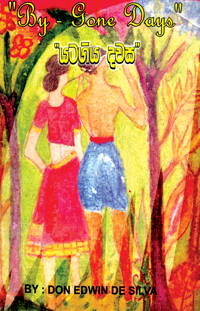Retrospect of bygone days
The internal migration of a segment of our population from the areas
to the South of Colombo staged towards late 19th Century and early 20th
Century to fill the hiatus in the business arena of the central regions
is a topic that has attracted certain academia. But they manage to couth
that content in such high flown and incomprehensible terminology that
makes the process almost elusive to the average reader. Well some are of
the opinion that, that is the expected job of the academic writer. Like
exclusive clubs that charge prohibitive fees.
The author of 'Bygone Days' may or may not have had this migration as
main focus but books like this where a tale is told straight and frankly
gives a direct insight into this interesting sociological process. The
main catalyst of these migrations was the plantation economy of the
uplands that opened the window on many business and trade opportunities.
But this de Silva family had been driven to the city of Elephants or
Kurunegala by the Second World War.
 Whether the other families that drifted from the South to this city
circumscribed by rocks that according to legend metamorphosed from
enlarged animals, were also driven there in the 1940s to evade the one
or two Japanese bombs that fell on Colombo is not clear from the book.
Anyway no one foresaw the strange fact on Colombo is not clear in the
book. Whether the other families that drifted from the South to this city
circumscribed by rocks that according to legend metamorphosed from
enlarged animals, were also driven there in the 1940s to evade the one
or two Japanese bombs that fell on Colombo is not clear from the book.
Anyway no one foresaw the strange fact on Colombo is not clear in the
book.
Anyway no one foresaw the strange fact that this city less than 100
years would become the most bombed city in the world.
Here is a quote from the book that gives an interesting cross-section
of the migrated population of the South. 'The families from the South
were the de Silvas and Peirises who came from Aluthagama, Bentota and
Weligama.
The Fernandos and Coorays from Maggona, The de Zoysas and Thabrews
from Kosgoda and Balapitiya and the Mendises from Moratuwa.'
Here we see the indigenous population of Kurunegala mostly comprising
Sinhala goiyas and a sprinkling of Tamils and Muslims turning colourful
with these additions flavoured with names from the West and tinctured to
some extent with Western culture. The de Silvas however remain staunch
Buddhists patronising the premier temples in Kurunegala, that is
Ethkanda Viahara and Ridi Vihara. A curious bit of information is given
that the spot where the Ridi to Silver Vihara was built, was initially a
halt of Dutugemunu's army en route to Anuradhapura for the war with
Elara. 'Most Southern families were related to each other and majority
of them were traders in some related enterprise. Their greatest interest
was to deal in consumer goods, mostly in marketing groceries,
vegetables, fruits, meat and fish', goes on the writer. The central
market stands had all been rented by them and they used the upcoming
railway lines to transport consumer goods in bulk including fish. Only
the meat industry the Sinhala Buddhist entrepreneurs did not dabble in
leaving it to Coorays from Maggona who were Roman Catholics.
Most of the families prospered and a good many of their offspring
like the author took to professional fields too, thereby progressing
more, travelling abroad and opening gateways to their own offspring too
to savour the creature comforts of the West while deriding them too at
times.
A 90-year old man narrates it all makes the book more interesting.
Here is a writer who had been inspired by the oratory of the likes of P
de S Kularatne, Ven. Tibet S Mahnda Thera and other national patriots of
the time. His alma mater was Ananda College slowly blossoming into a
venue of producing the country's patriotic leaders. The first
catastrophe in the life of this lucky person was the death of his wife
he loved dearly. What did he do then? Get into a cocoon of self-pity and
weep day and night? No. Curse the gods? No.
The reviewer remembers a funeral she attended where the wife had
passed away suddenly due to an illness. To everybody's embarrassment the
husband was indulging in a frenzied devil - dance cursing all the gods
and questioning whether such beings really exist. He himself died a few
months later, religion never coming to his aid to bring peace to his
mind. The gods accursed by him to naturally kept away. Here is Edwin de
Silva who had found a much better alternative.
Quote a piece from the preface written by Prof. N A Jayawicrema:
"After the death of his beloved wife he was faced with loneliness. So
this happened to be the time that memories of the past started to haunt
his life. Thus began Yatagiya davsa to overcome his loneliness." The
book certainly does not aspire to be a literary masterpiece.
Sometimes it just goes on listing facts. But it does have its
significance including the sociological aspects and the mentally
catharsis value. And the author himself has lived the tale/making the
book authentic.
- Padma Edirisinghe
|



